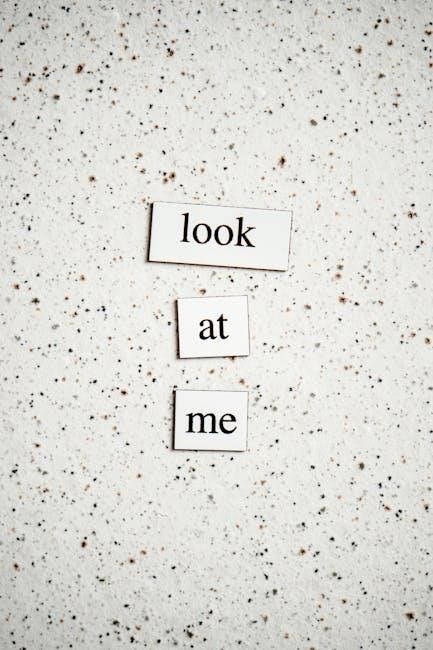
A First Look at Communication Theory by Em Griffin provides a comprehensive introduction to the field, exploring key concepts, models, and theories that shape human communication.
Overview of Communication Theory
Communication theory examines how information is created, transmitted, and interpreted between individuals, groups, or organizations. It provides a framework for understanding the complex processes involved in human interaction. A First Look at Communication Theory by Em Griffin offers insights into the foundational concepts, such as verbal and non-verbal communication, and how these elements shape meaning. The book explores various theories and models, like the Shannon-Weaver model, to illustrate how messages are encoded, decoded, and exchanged. By studying communication theory, individuals gain a deeper understanding of interpersonal dynamics, cultural influences, and the impact of technology on interactions. Griffin’s work serves as a comprehensive resource for students and scholars seeking to grasp the nuances of communication in diverse contexts.
Importance of Studying Communication Theory
Studying communication theory is essential for understanding how individuals, groups, and organizations interact effectively; It provides insights into the processes of encoding, decoding, and interpreting messages, helping to improve interpersonal and professional relationships. By analyzing theories like the Shannon-Weaver model, individuals can identify barriers to communication and develop strategies to overcome them. A First Look at Communication Theory by Em Griffin emphasizes the practical applications of these concepts, enabling readers to navigate diverse communication scenarios more effectively. Whether in personal interactions or global contexts, communication theory offers a foundation for fostering understanding, collaboration, and conflict resolution, making it a vital field of study in today’s interconnected world.
Key Concepts in Communication Theory
A First Look at Communication Theory introduces fundamental concepts such as senders, receivers, messages, channels, feedback, and noise, essential for understanding effective communication processes.

Definition of Communication
Communication is the process of exchanging information, ideas, or messages between individuals, groups, or entities through verbal or non-verbal means. According to Em Griffin in A First Look at Communication Theory, communication involves a sender, receiver, message, channel, feedback, and noise. The sender encodes a message, which is transmitted via a channel to the receiver, who decodes it. Feedback ensures the message is understood, while noise refers to any interference. Griffin emphasizes that communication is not just about sending a message but also about creating a shared meaning. This definition underscores the dynamic and interactive nature of communication, highlighting its importance in connecting people and facilitating understanding across various contexts.
Models of Communication
In A First Look at Communication Theory, Em Griffin explores various models that illustrate how communication works. The Shannon-Weaver Model, one of the earliest, describes communication as a linear process involving a sender, encoder, channel, decoder, receiver, and noise. Another key model is the Transactional Model, which emphasizes mutual communication and the role of personal and social contexts. Griffin also discusses the Linear Model and the Interactional Model, highlighting their differences. These models provide frameworks for understanding how messages are sent, received, and interpreted. By examining these models, Griffin demonstrates how communication can be analyzed systematically, helping to identify strengths and weaknesses in various communication scenarios. These models remain foundational in studying communication theory and its practical applications.
Types of Communication: Verbal and Non-Verbal

Communication can be broadly categorized into verbal and non-verbal types. Verbal communication involves the use of words, both spoken and written, to convey messages. It relies on language, syntax, and tone of voice to transmit meaning. Non-verbal communication, on the other hand, includes gestures, facial expressions, body language, and eye contact. These cues often reinforce or even contradict verbal messages, adding depth to interactions. Griffin highlights how non-verbal signals can be subconscious yet highly influential. Understanding both types is crucial for effective communication, as they often work together to convey intent and emotion. In A First Look at Communication Theory, Griffin emphasizes the interconnectedness of these forms, showing how they shape our interactions in subtle yet powerful ways. This distinction helps communicators better navigate diverse social and cultural contexts.
The Evolution of Communication Theory
Communication theory has evolved from early transmission models to dynamic, interactive frameworks, reflecting advances in technology and understanding of human interaction complexities over time.
Historical Development of Communication Theory
Communication theory traces its roots to ancient civilizations, where verbal and non-verbal exchanges laid the groundwork for understanding human interaction. In the early 20th century, scholars like Claude Shannon and Warren Weaver pioneered the field with the Shannon-Weaver model, focusing on information transmission. The 1960s and 1970s saw a shift toward dynamic, interactive models, emphasizing feedback and context. The transactional model emerged, highlighting communication as a reciprocal process. By the 1980s, constructivist theories gained prominence, stressing how individuals create meaning. The 1990s brought attention to cultural and relational aspects, broadening the scope. Each era built on the last, shaping a multifaceted field that continues to evolve with technological and societal changes, reflecting humanity’s enduring quest to connect and understand one another.
Impact of Technology on Communication Theory
Technology has profoundly shaped communication theory, transforming how messages are conveyed and received. The advent of the internet, social media, and digital platforms has redefined traditional communication models, enabling instant global connectivity. These tools have introduced new dimensions to theories, such as the transactional model, by emphasizing real-time feedback and interactivity. Digital communication has also raised questions about authenticity, privacy, and information overload. The rise of AI-driven tools like chatbots further complicates theories by introducing non-human agents into interactions. Technology continues to evolve, challenging existing frameworks and prompting new research into the dynamics of digital communication. As a result, communication theory must adapt to remain relevant in an increasingly tech-driven world, addressing both opportunities and challenges brought by these advancements.

Major Theories in Communication

Major communication theories include the Shannon-Weaver model, transactional model, constructivist theory, and cultural studies. These frameworks explore how messages are created, transmitted, and interpreted in various contexts.
Shannon-Weaver Model
The Shannon-Weaver Model, developed by Claude Shannon and Warren Weaver, is a foundational framework in communication theory. It outlines the process of communication as a linear, one-way transmission of information. The model identifies five key components: the source (message creator), encoder (translates the message), channel (medium of transmission), decoder (interprets the message), and receiver (message recipient). It also introduces the concept of noise, which refers to any interference that disrupts the communication process. Initially designed for technical communication, the model has been widely applied to human interaction. Its simplicity makes it a valuable starting point for understanding how messages are sent and received, though it lacks feedback mechanisms, making it less suitable for complex, two-way interactions.
Transactional Model of Communication
The Transactional Model of Communication, developed by Dean Barnlund, emphasizes the dynamic and reciprocal nature of communication. Unlike linear models, it views communication as a two-way process where both parties act as senders and receivers simultaneously. The model highlights the role of feedback, enabling continuous interaction and adjustment of messages. It also considers the context in which communication occurs, including physical, cultural, and social environments. This model recognizes that messages are interpreted based on individual experiences, making communication highly subjective. By acknowledging the complexity of human interaction, the Transactional Model provides a more comprehensive understanding of how people negotiate meaning and adapt their communication strategies in real-time. It is particularly useful for understanding interpersonal and group communication dynamics.
Constructivist Theory
Constructivist Theory posits that individuals actively construct their own understanding of reality through interactions and experiences. This theory emphasizes that meaning is not passively received but is instead created by the communicator. It suggests that people interpret messages based on their unique perspectives, experiences, and cultural backgrounds. Constructivist Theory highlights the role of context and interpretation in shaping communication outcomes. Unlike other theories, it focuses on the active role of the receiver in creating meaning. This approach is particularly relevant in understanding how individuals perceive and interpret the same message differently. By emphasizing the subjective nature of communication, Constructivist Theory provides insights into the complexities of human interaction and the importance of considering diverse perspectives in communication processes.
Cultural Studies and Communication
Cultural studies and communication explore how culture shapes and is shaped by communication processes. Culture influences language, norms, values, and symbols, which are central to human interaction. This field examines how cultural identities are constructed and negotiated through communication. It emphasizes the role of power dynamics, social structures, and media in shaping cultural narratives. Cultural studies also address how globalization has led to the blending and clash of cultures, creating new communication challenges. Understanding cultural differences is crucial for effective cross-cultural communication. By analyzing the interplay between culture and communication, scholars aim to foster inclusivity and reduce misunderstandings in diverse social contexts. This perspective highlights the importance of cultural competence in navigating the complexities of global communication.

Applications of Communication Theory
Communication theory applies to various sectors, enhancing interactions, developing strategies, and improving understanding of human behavior, making it relevant in education, business, media, and personal relationships.
Communication Theory in Business
Communication theory plays a vital role in business by enhancing interactions, fostering collaboration, and driving organizational success. It helps leaders develop clear messaging, manage conflicts, and build trust within teams, ensuring alignment with company goals. Effective communication strategies improve client relationships, brand messaging, and customer service, which are essential for maintaining a competitive edge. By understanding communication dynamics, businesses can optimize internal processes, engage employees, and adapt to market changes. The application of communication theory in business also extends to conflict resolution, negotiation, and cultural sensitivity, ensuring a harmonious and productive work environment. Ultimately, it serves as a foundation for sustainable growth and innovation in the corporate world.
Communication Theory in Education
Communication theory is essential in education, as it facilitates the exchange of knowledge, ideas, and values between teachers, students, and institutions. Effective communication enhances learning outcomes by ensuring clarity in instruction, fostering student engagement, and promoting active participation. It also strengthens teacher-student relationships, enabling personalized feedback and support. Non-verbal cues, such as body language and tone, play a significant role in conveying empathy and enthusiasm, which are critical for motivation. Additionally, communication theory helps address diverse learning needs by encouraging inclusive practices and adaptability. Technology has further transformed educational communication, with digital tools enabling remote learning and collaborative projects. By applying communication theory, educators can create dynamic, inclusive, and effective learning environments that cater to the needs of all students, ultimately improving academic success and lifelong learning skills.
Communication Theory in Media and Journalism
Communication theory plays a vital role in media and journalism by guiding how messages are created, transmitted, and interpreted. It helps journalists and media professionals understand audience reception, ensuring clarity and effectiveness in reporting. Theories like agenda-setting and framing influence how stories are prioritized and presented, shaping public perception. The rise of digital media has introduced new communication dynamics, with social platforms altering how news is disseminated and consumed. Journalists must adapt to these changes, using theories to navigate evolving communication landscapes. Effective communication in media is crucial for maintaining credibility and fostering informed public discourse, emphasizing the ongoing relevance of communication theory in contemporary journalism.

Modern Perspectives on Communication Theory
Modern perspectives on communication theory emphasize globalization, digital media, and cultural diversity, exploring how technology and ethics shape contemporary interactions and societal connections effectively today.
Globalization and Communication

Globalization has profoundly shaped modern communication, fostering interconnectedness across cultures and borders. It highlights the role of communication in bridging cultural divides, enabling global collaboration, and facilitating cultural exchange. The rise of international businesses, global media, and digital platforms has made cross-cultural communication essential. However, globalization also presents challenges, such as cultural homogenization and language barriers, which can hinder effective understanding. Communication theories now emphasize the importance of adaptability, empathy, and cultural competence in navigating these dynamics. By examining how globalization influences communication patterns, scholars gain insights into the complexities of identity, power, and representation in a globalized world. This perspective underscores the transformative potential of communication in addressing global challenges and fostering unity amidst diversity.
Digital Communication and Social Media
Digital communication and social media have revolutionized how individuals and organizations interact, reshaping traditional communication theories. Social media platforms, such as Facebook, Twitter, and Instagram, have enabled instant, global connectivity, fostering new forms of dialogue and collaboration. Digital tools like messaging apps, video conferencing, and emails have transformed the way people share information and maintain relationships. These technologies have introduced new concepts like viral content, influencers, and online identities, challenging conventional notions of communication. While digital platforms enhance accessibility and speed, they also raise concerns about privacy, misinformation, and the blurring of personal and professional boundaries. Understanding these dynamics is crucial for navigating the complexities of modern communication in an increasingly digital world.
Artificial Intelligence and Communication
Artificial intelligence (AI) is transforming communication by enabling smarter, more personalized interactions. Chatbots, virtual assistants, and automated systems now mediate interactions, enhancing efficiency and accessibility. AI algorithms analyze vast datasets to predict behaviors, tailor messages, and optimize communication strategies. Natural Language Processing (NLP) allows machines to understand and generate human-like text, revolutionizing customer service and content creation. However, AI also raises ethical concerns, such as privacy violations, bias in algorithms, and the potential for misinformation. Despite these challenges, AI holds immense potential to improve communication accuracy, reduce barriers, and create innovative ways to connect people globally. As technology advances, understanding AI’s role in communication becomes essential for fostering effective and ethical interactions in a rapidly evolving world.
Challenges in Communication Theory
Communication theory faces challenges like noise interference, cultural barriers, and technological limitations, impacting message clarity and interpretation across diverse contexts and audiences.
Barriers to Effective Communication
Effective communication is often hindered by various barriers that disrupt the flow of information. Physical barriers, such as noise, distance, or technological malfunctions, can obstruct message transmission. Emotional barriers, including stress, anxiety, or fear, may prevent individuals from expressing themselves clearly. Perceptual barriers, like biases or preconceived notions, can lead to misinterpretation of messages. Language barriers, such as differences in vocabulary or accents, also pose challenges. Additionally, cultural barriers, including varying communication styles and norms, can create misunderstandings. Overcoming these barriers requires awareness, empathy, and the use of strategies to ensure clarity and understanding in interactions.
Cross-Cultural Communication Challenges

Cross-cultural communication challenges arise when individuals from different cultural backgrounds interact, often leading to misunderstandings. Language differences are a primary obstacle, as dialects, slang, and interpretations of words vary widely. Non-verbal cues, such as body language and facial expressions, also differ across cultures, potentially causing misinterpretation. Cultural norms and values, like collectivism vs. individualism, influence communication styles, creating friction. Stereotypes and biases further complicate interactions, as preconceived notions may lead to inaccurate assumptions. Additionally, technological barriers, such as limited access to communication tools in some regions, can hinder cross-cultural exchanges. Addressing these challenges requires cultural sensitivity, open-mindedness, and a willingness to adapt communication strategies to bridge cultural gaps effectively.
Ethical Issues in Communication
Ethical issues in communication arise when interactions involve conflicts of interest, misinformation, or violations of privacy. One major concern is the spread of misinformation, which can mislead audiences and undermine trust. Privacy violations, such as unauthorized sharing of personal information, pose significant ethical dilemmas. Additionally, issues like persuasion versus manipulation often blur the lines of ethical communication. Cultural insensitivity and biased representations in media can perpetuate stereotypes, raising ethical questions about representation. Furthermore, the balance between free speech and harmful speech, such as hate speech or harassment, is a recurring ethical challenge. Addressing these issues requires a commitment to honesty, transparency, and respect for diversity to ensure communication remains ethical and responsible.

Future Directions in Communication Theory
Future directions in communication theory focus on emerging technologies, globalization, and interdisciplinary approaches. Researchers explore AI, virtual reality, and data-driven communication to shape the field.
Emerging Trends in Communication Research
Emerging trends in communication research emphasize the integration of technology, ethics, and cultural perspectives. Artificial intelligence and machine learning are reshaping how communication is studied and applied. Researchers are exploring virtual and augmented reality as tools for immersive communication experiences. Additionally, there is a growing focus on ethical communication in the digital age, addressing issues like privacy, misinformation, and algorithmic bias. Interdisciplinary approaches are becoming essential, blending insights from psychology, sociology, and data science. These trends highlight the dynamic nature of communication theory, adapting to global challenges and technological advancements. By prioritizing innovation and inclusivity, communication research continues to evolve, offering new frameworks for understanding human interaction in diverse contexts.
The Role of Communication Theory in the Digital Age
Communication theory plays a pivotal role in understanding interactions in the digital age. It provides frameworks to analyze how technology influences human connection, from social media platforms to virtual meetings. Theories such as media richness and social presence help explain how digital tools shape communication quality. Additionally, communication theory addresses challenges like information overload and the blurring of boundaries between personal and professional life. It also guides strategies for effective digital storytelling, audience engagement, and crisis communication. By applying theoretical principles, individuals and organizations can navigate the complexities of digital communication, fostering meaningful interactions and building trust in an increasingly online world. These insights are crucial for adapting to the rapid evolution of digital landscapes.
Communication theory is essential for understanding interactions in various contexts, offering insights into human behavior and relationships. Its principles guide effective communication across cultures, technologies, and industries.
Communication theory provides a foundation for understanding how information is transmitted, received, and interpreted. It explores models like Shannon-Weaver and transactional communication, emphasizing verbal and non-verbal interactions. The field highlights the impact of culture, technology, and globalization on communication dynamics. Key theories, such as constructivism and cultural studies, explain how meaning is constructed and shared. Practical applications in business, education, and media demonstrate its relevance. Challenges like barriers, cross-cultural differences, and ethical issues underscore the complexity of effective communication. Emerging trends, including digital platforms and AI, reshape communication practices. Ultimately, communication theory remains vital for navigating interpersonal and global interactions in an evolving world.
Final Thoughts on the Importance of Communication Theory
Communication theory serves as a cornerstone for understanding human interaction, offering insights into how messages are created, shared, and interpreted. Its principles are invaluable for fostering effective dialogue in personal and professional settings. By studying communication theory, individuals can navigate cultural differences, technological advancements, and ethical dilemmas with greater awareness and sensitivity. In a globally interconnected world, the ability to communicate effectively is not just a skill but a necessity. Communication theory equips us with the tools to build stronger relationships, resolve conflicts, and collaborate meaningfully. Its relevance spans industries, from education to media, emphasizing its enduring importance in shaping how we connect and coexist. Ultimately, communication theory reminds us that meaningful interaction is the foundation of a harmonious and productive society.


